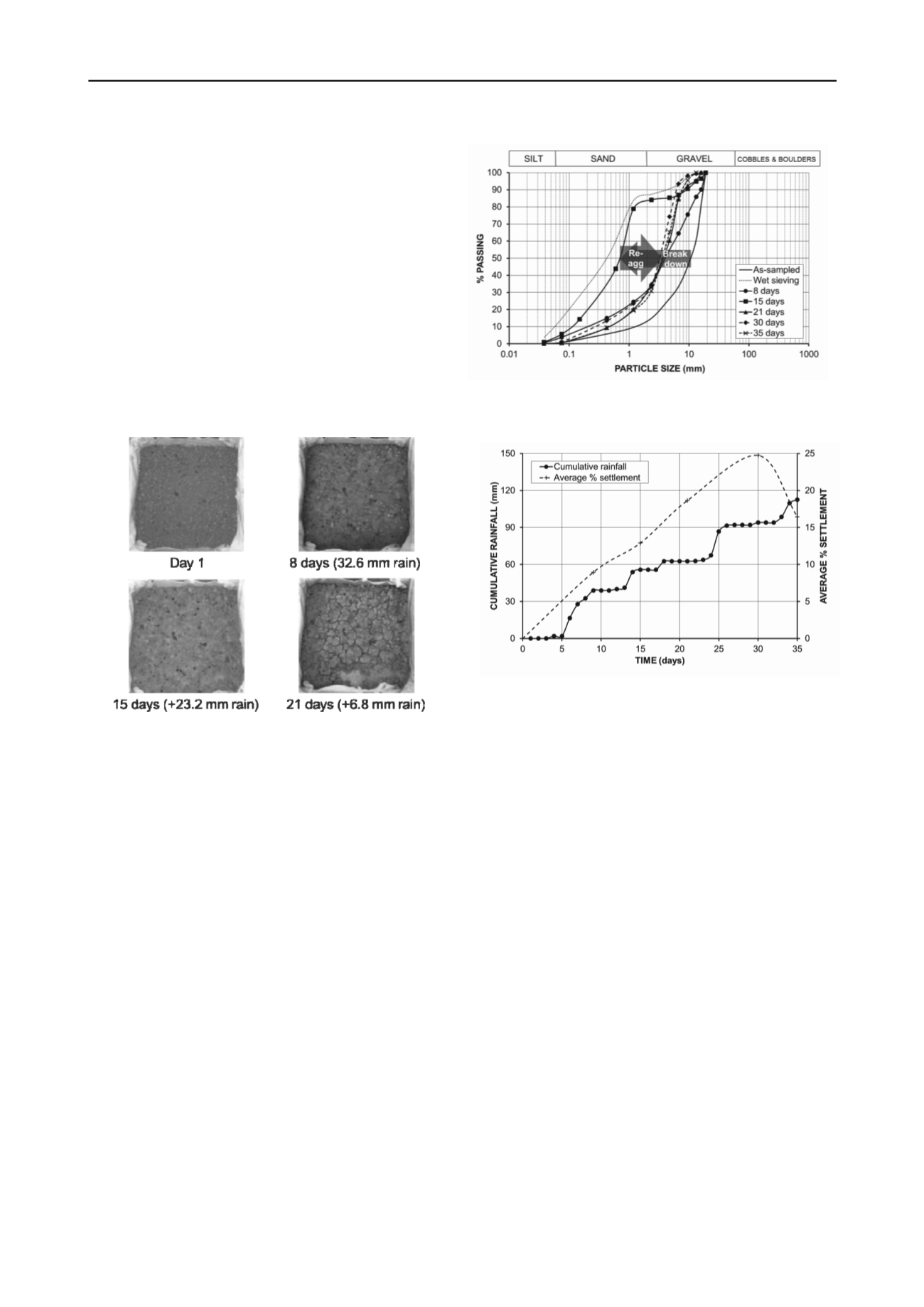
444
Proceedings of the 18
th
International Conference on Soil Mechanics and Geotechnical Engineering, Paris 2013
Proceedings of the 18
th
International Conference on Soil Mechanics and Geotechnical Engineering, Paris 2013
600 mm square by 150 mm deep and left exposed to the weather
for 35 days, during which time it experienced wetting by a
number of rainfall events totalling 113 mm, with desiccation
between these rainfall events. The rainfall was recorded, the net
settlement of the surface was measured regularly at nine points
over the area of the specimen, and sub-samples were taken at
the same time intervals for air-drying and dry sieving to
determine the change in the particle size distribution.
The specimen underwent major particle breakdown,
followed by re-agglomeration on desiccation crusting, as shown
visually in Figure 8. Changes in particle size distribution during
the course of the degradation test are shown in Figure 9. Figure
10 shows the cumulative rainfall and average net % settlement
relative to the initial specimen height with time during the
degradation test. Both Figures 9 and 10 clearly show the effects
of the initial major particle breakdown and subsequent re-
agglomeration, leading to reversals in the particle size
distribution curves and average net % settlement.
Figure 9. Changes in particle size distribution curves with time during
degradation test on loose-placed, -19 mm scalped Jeebropilly weathered
rock.
Figure 10. Cumulative rainfall and average net % settlement relative to
the initial specimen height with time during degradation test on loose-
placed, -19 mm Jeebropilly weathered rock.
Figure 8. Photographs of major particle breakdown and re-
agglomeration on crusting during degradation test on loose-placed, -
19 mm scalped Jeebropilly weathered rock.
8 CONCLUSION
7 COMBINED SETTLEMENT OF JEEBROPILLY
WEATHERED ROCK
Based on the results of the laboratory testing, the self-weight
settlement of initially relatively dry, loose-dumped, uncemented
Jeebropilly weathered rock spoil under 500 kPa (equivalent to a
spoil pile height of about 30 m) could amount to about 15% of
the initial spoil height, of 6% (20% of this) would likely occur
post-construction. Wetting-up of loose-dumped, uncemented
Jeebropilly weathered rock spoil could cause collapse
settlement of a further 15% of the initial spoil height.
Degradation-induced settlement of loose, uncemented
Jeebropilly weathered rock spoil could be 15 to 25% of the
initial height, although this might only occur to limited depth.
Overall, the combined settlement of a 30 m high pile of loose-
dumped, uncemented Jeebropilly weathered rock spoil, also
subjected to collapse and degradation on wetting-up, could be
up to 36 to 46% of the initial loose spoil height.
The laboratory testing of uncemented Jeebropilly weathered
rock spoil has identified and quantified the components of
settlement on loading under dry and wet conditions, and on
wetting-up alone. These are substantial and reduce, to a
relatively modest amount, the initial considerable bulking on
excavation and loose-dumping of the overburden in spoil piles.
The final dry density of a high spoil pile of uncemented
weathered rock spoil could eventually approach that achieved
by laboratory Standard compaction of the material.
9 ACKNOWLEDGEMENTS
The research on which this paper is based forms part of
Australian Coal Association Research Program Project C19022,
whose funding is greatly appreciated, as are Jeebropilly Coal
Mine personnel for assisting with spoil sampling.
Coal mine open pits up to 500 m deep are being planned in
the Hunter Valley Coalfields of New South Wales, Australia,
which would result in spoil piles up to 600 m high. These could
settle about 40% of the initial loose spoil height, resulting in a
net bulking of the order of 12% relative to the initial
in situ
dry
density of about 1.87 t/m
3
.
10 REFERENCES
AS 1289.
Testing Soils for Engineering Purposes
. Standards Australia.
Naderian, A.R., Williams, D.J. and Clark, I.H. 1996. Numerical
modelling of settlements in back-filled open-cut mines.
International Journal of Surface Mining, Reclamation, and
Environment
, 10, 25-29.
Simmons J. 1995. Slope Stability for Open Cut Coal Mining.
Australian
Geomechanics Journal
, 29, 45-57.
U.S.D.A. 1954.
U.S.D.A. Agricultural Handbook No. 60, Diagnosis and
Improvement of Saline and Alkali Soils
.


